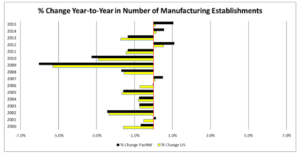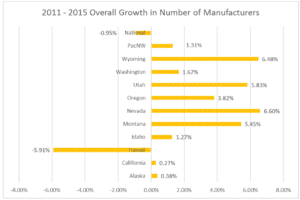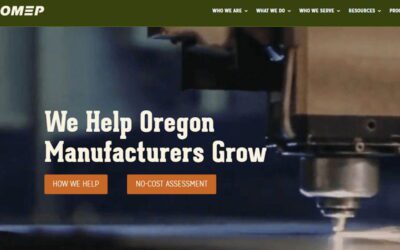In three of the last four years, the number of national manufacturing establishments grew according to the U.S. Census Bureau County Business Patterns, which may be a surprising but welcomed trend.
As NIST MEP regional managers, we examined this trend as it related to the Pacific Northwest region and in comparison to national trends. With more establishments, the future potential for diversified growth and more jobs in manufacturing may be stronger.
The Pacific Northwest is one of six regions covered by NIST MEP and includes Alaska, California, Hawaii, Idaho, Montana, Nevada, Oregon, Washington, Wyoming, and Utah. Looking at Chart 1 below, from 2011 – 2015 there was an increase in the number of manufacturing establishments in three of the last four years. In fact, the region saw even greater growth in the number of manufacturing establishments compared to U.S trends, during those years.

We also compared the overall, absolute number of manufacturers in 2015 compared to 2011, in the region versus the nation in Chart 2. This show that the total number of U.S. manufacturers was still down in 2015 compared to 2011 even after the growth in three of the four years.
In contrast, all the Pacific Northwest region states except Hawaii showed an overall increase in the number of manufacturers in 2015 compared to 2011 led by Montana, Nevada, Oregon, Utah and Wyoming at rates almost four to six times the national growth over the same time period.
California accounts for 66% of the manufacturing establishments in the region. However, California only saw a 0.27% increase in the number of establishments over that same time frame, basically remaining stable.
In talking with the MEP Center Directors in the region, they offered several anecdotal reasons for the growth in manufacturing establishments:
- Costs are rising in China and elsewhere, combined with other factors of risk making manufacturing in the U.S. an attractive option;
- In several states as larger, older corporations and industries transition out (oil and gas, lumber, etc.), people have instead started new businesses in their communities;
- In some states like Nevada, larger companies have relocated major facilities, and suppliers have moved to be close for better supplier relations.
A look at the 2011 to 2015 timeframe showed that the Pacific Northwest growth occurred over several size categories of manufacturing firms, not just the smallest or startups.
The industries exhibiting major growth included beverage (breweries, wineries, sports drinks, etc.) by over 50%, with much smaller increases in food (6.03%) and chemical manufacturing (5.57%) respectively.
How can we take these positive trends and expand them across the nation?
That is a great challenge and a worthy goal. The Boston Consulting Group issued several reports highlighting the changing economics of global competitiveness and suggesting the growth of manufacturing in the U.S. is a result of labor prices increasing overseas and proximity to markets. We at NIST MEP are working diligently with manufacturers and communities to help grow manufacturing in the U.S. – perhaps we are seeing the beginning of a full-scale trend. Let’s take these lessons and empower our manufacturers not just in the Northwest but across the nation.
The National Institute of Standards and Technology’s Hollings Manufacturing Extension Partnership (MEP) works with small and mid-sized U.S. manufacturers to help them create and retain jobs, increase profits, and save time and money. The MEP National Network provides a variety of services, from innovation strategies and process improvements to green manufacturing. MEP also works with partners at the state and federal levels on programs that put manufacturers in position to develop new customers, expand into new markets and create new products. The National Network has close to 1,300 field staff serving as trusted advisors and technical experts – located in every state and Puerto Rico – focused on solving manufacturers’ challenges and identifying opportunities for growth. As a program of the U.S. Department of Commerce, MEP offers its clients a wealth of unique and effective resources centered on five critical areas: technology acceleration, supplier development, sustainability, workforce and continuous improvement.
Learn More about NIST MEP Here



